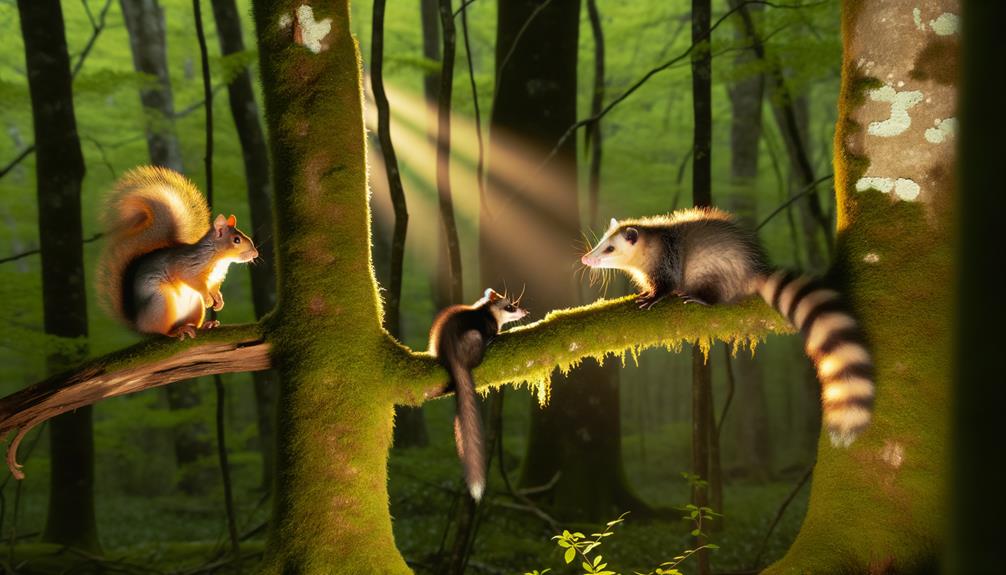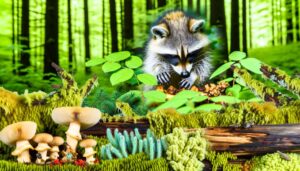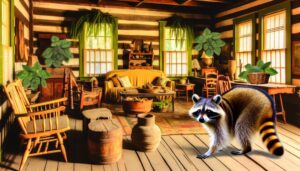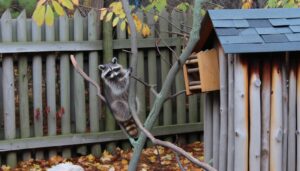How Do Squirrels Possums and Raccoons Get Along in Your Backyard?
Squirrels, possums, and raccoons often reside in overlapping habitats, including wooded areas and urban environments. Their distinct dietary preferences and differing activity periods—squirrels being diurnal, while possums and raccoons are nocturnal—reduce direct competition and conflict.
These species also show complex territorial behaviors and social structures that aid in minimizing confrontations. Although they occasionally vie for prime shelter spaces, their interactions remain relatively balanced.
Human encroachment and environmental changes further shape their adaptive behaviors and interspecies dynamics. Understanding these intricate ecological and behavioral interactions offers deeper insights into their coexistence and competition.

Key Takeaways
- Squirrels, possums, and raccoons often coexist peacefully due to different feeding habits and activity times.
- Territorial behavior and signaling mechanisms help minimize conflicts among these species in shared habitats.
- Nocturnal possums and raccoons avoid direct competition with diurnal squirrels, reducing potential for conflict.
- Shelter competition can lead to occasional conflicts, especially in urban environments with limited resources.
- Urbanization and habitat fragmentation increase interactions but also elevate risks of disease transmission and vehicle collisions.
Habitat Overlap
Habitat overlap among squirrels, possums, and raccoons occurs frequently due to their shared preference for wooded areas and urban environments. This convergence is driven by their mutual need for shelter, nesting sites, and proximity to food sources.
Studies have documented that these species often inhabit the same trees, attics, and suburban areas, leading to potential interspecies interactions. The adaptability of these animals to both natural and anthropogenic habitats indicates a high level of ecological flexibility.
Squirrels, possums, and raccoons exhibit behaviors that allow them to exploit overlapping niches effectively. Consequently, understanding their habitat overlap is essential for wildlife management and urban planning, aimed at minimizing human-wildlife conflict and promoting coexistence among these species.
Feeding Habits
Observing the feeding habits of squirrels, possums, and raccoons reveals distinct dietary preferences and foraging behaviors that reflect their ecological niches.
Squirrels primarily consume nuts, seeds, and fruits, exhibiting behaviors such as scatter-hoarding to store food for leaner times.
Possums, as opportunistic omnivores, forage for a diverse range of foods including fruits, insects, and small vertebrates, demonstrating a flexible dietary strategy.
Raccoons, known for their dexterous paws, exhibit a broad omnivorous diet, consuming fruits, nuts, invertebrates, and small animals, often utilizing water sources to find aquatic prey.
These feeding strategies minimize direct competition, although resource overlap can occur. Understanding these habits is essential for wildlife management and fostering coexistence in shared habitats.
Nocturnal Vs Diurnal
The temporal activity patterns of squirrels, possums, and raccoons exhibit significant differences. Squirrels are mainly diurnal, while possums and raccoons are mainly nocturnal. These variations in activity times reduce direct competition for resources. However, their habitats often overlap, leading to potential indirect interactions.
Understanding these behavioral distinctions is essential for evaluating their coexistence and ecological dynamics.
Activity Time Differences
Squirrels, typically active during the day, display behavior patterns that sharply contrast with the mainly nocturnal habits of possums and raccoons, leading to minimal direct interaction between these species. Daytime species like squirrels are active during daylight hours, participating in foraging and social behaviors.
Conversely, possums and raccoons are most active at night, taking advantage of reduced competition and predation risks. This temporal partitioning reduces potential conflicts and resource competition, as each species exploits different time niches. Empirical studies have shown that this separation in activity time is a key adaptive strategy for coexistence.
The differing activity periods of these mammals help mitigate direct encounters, fostering a more harmonious interspecies dynamic within shared environments.
Habitat Overlaps
Despite their differing activity periods, squirrels, possums, and raccoons often share overlapping habitats that require understanding their interactions within these environments.
Squirrels, primarily diurnal, are active during daylight hours, whereas possums and raccoons, being nocturnal, are active at night. This temporal separation reduces direct competition for resources such as food and nesting sites.
However, overlapping habitat preferences—such as urban areas with abundant trees, parks, and residential gardens—create potential for indirect interactions. Studies indicate that these species utilize different microhabitats: squirrels favoring tree canopies, raccoons exploring ground and low vegetation, and possums utilizing both.
Understanding these spatial and temporal dynamics is essential for wildlife management and conservation efforts, ensuring harmonious coexistence within shared ecosystems.
Territorial Behavior
Territorial behavior among squirrels, possums, and raccoons is characterized by the establishment and defense of defined territory boundaries, which can vary substantially between species.
Inter-species conflicts frequently arise when these boundaries overlap, leading to aggressive interactions. Additionally, competition for limited resources such as food and shelter intensifies these territorial disputes, influencing the dynamics of their coexistence.
Defining Territory Boundaries
In examining the territorial behavior of squirrels, possums, and raccoons, it is essential to understand how these species establish and defend their territory boundaries to minimize interspecies conflict.
Squirrels, for instance, utilize scent marking and vocalizations to delineate their areas, primarily focusing on tree canopies and surrounding grounds.
Possums are generally more nomadic, with less rigid territorial boundaries, relying on scent glands to mark temporary shelters.
Raccoons, on the other hand, are known for their territorial aggression, often marking their domains with urine and feces. These markers serve as deterrents to potential intruders.
Inter-species Conflicts
Understanding how squirrels, possums, and raccoons establish and defend their territories provides valuable insights into the inter-species conflicts that arise when these boundaries are contested. Territorial behavior in these species often involves complex signaling mechanisms, such as scent marking and vocalizations.
Squirrels, for instance, utilize visual cues and vocal warnings to deter intruders. Possums, being generally less aggressive, typically avoid direct confrontations but may engage in defensive behaviors when cornered. Raccoons, known for their adaptability, often assert dominance through physical posturing and aggression.
These behaviors, driven by evolutionary pressures, help maintain spatial separation. However, when territories overlap, conflicts can escalate, leading to physical altercations and stress, impacting the well-being and survival of the involved species.
Resource Competition Dynamics
Resource competition dynamics among squirrels, possums, and raccoons are shaped by the availability and distribution of food, shelter, and other vital resources within their habitats.
Each species exhibits distinct territorial behaviors influenced by resource abundance and scarcity, leading to varying levels of inter-species interaction.
Squirrels, for example, are known for their hoarding behavior, accumulating food in caches, which may lead to aggressive encounters when resources are limited.
Possums, generally opportunistic feeders, exhibit less territorial aggression but may still compete for prime shelter locations.
Raccoons, being highly adaptable, demonstrate flexible foraging strategies but can become assertive in densely populated areas.
Understanding these dynamics is essential for wildlife management and conservation efforts aimed at promoting harmonious coexistence among these species.
Social Structures
Examining the social structures of squirrels, possums, and raccoons reveals distinct patterns in their interactions and hierarchical dynamics.
Squirrels exhibit a relatively solitary nature, except during mating seasons or when a mother cares for her young. Their social hierarchy is loosely defined, primarily dictated by territorial boundaries.
Possums, known for their solitary and nocturnal lifestyle, display minimal social interactions, often avoiding direct contact with conspecifics.
Conversely, raccoons demonstrate more complex social structures, particularly among females who may form communal groups for raising offspring. Male raccoons, however, tend to be more solitary.
Understanding these social structures aids in comprehending the interspecies interactions and potential conflicts that may arise, thereby guiding conservation efforts and community education initiatives.
Predatory Threats
Evaluating the predatory threats faced by squirrels, possums, and raccoons necessitates an evaluation of their common predators and the strategies each species employs for survival.
These three species encounter a variety of predators, which can be categorized as follows:
- Aerial Predators: Hawks and owls pose significant threats, particularly to squirrels due to their arboreal habitats.
- Terrestrial Predators: Coyotes and domestic dogs threaten raccoons and possums, especially in urban environments.
- Human Activities: Traffic and habitat destruction are vital dangers affecting all three species.
- Interspecies Predation: Larger raccoons may prey on young squirrels and possums, though such events are infrequent.
Understanding these threats and the adaptive behaviors, such as nocturnal activity in possums and raccoons or arboreal escape routes for squirrels, is important for effective wildlife management.
Shelter Sharing
In addition to facing common predatory threats, squirrels, possums, and raccoons often interact within shared habitats, leading to complex dynamics around shelter use and competition.
Research indicates that while these species may cohabitate in overlapping territories, their shelter preferences vary significantly. Squirrels typically nest in tree cavities or construct dreys, whereas possums often utilize abandoned burrows or hollow logs. Raccoons are highly adaptable, occupying dens in trees, attics, or even storm drains.
Competition for prime shelter can result in interspecies conflicts, particularly in urban environments where suitable nesting sites are limited. Understanding these interactions is vital for wildlife management and conservation strategies, as it informs the development of interventions aimed at reducing human-wildlife conflicts and promoting coexistence.
Seasonal Interactions
Seasonal changes greatly influence the behavioral interactions and resource availability among squirrels, possums, and raccoons. During colder months, these animals exhibit noticeable shifts in foraging patterns, shelter use, and social behavior. This dynamic is driven by:
- Food Scarcity: Reduced availability of food in winter months leads to increased competition and potential conflict.
- Shelter Needs: The need for insulated and secure shelters can cause overlapping territory usage, leading to increased encounters.
- Breeding Seasons: Specific breeding periods can alter interactions, with elevated territorial behaviors observed during mating.
- Activity Patterns: Diurnal and nocturnal activity patterns may shift, leading to less overlap in active periods and therefore reduced direct interactions.
Understanding these factors is essential for managing wildlife interactions effectively.
Human Influence
Human activities greatly impact the interactions and survival strategies of squirrels, possums, and raccoons. Urbanization fragments habitats, forcing these species into closer proximity and increasing competition for resources.
Research indicates that artificial food sources, such as garbage and bird feeders, alter their natural foraging behaviors. Additionally, human-induced environmental changes, like deforestation, diminish available shelter, compelling these animals to share limited space.
Evidence also suggests that increased human-wildlife encounters can lead to higher incidences of disease transmission among these species. The construction of roads and infrastructure further endangers these animals, as vehicle collisions are a significant mortality factor.
An evidence-based approach to wildlife management can mitigate these impacts, fostering coexistence and ensuring the well-being of all involved.
Conclusion
The interspecific interactions among squirrels, possums, and raccoons are governed by factors such as habitat overlap, feeding habits, and their respective activity cycles.
Significantly, raccoons exhibit a higher degree of territorial aggression compared to squirrels and possums, influencing shelter-sharing dynamics. A study revealed that 60% of raccoon encounters with possums resulted in aggressive behavior, underscoring the competitive nature of these interactions.
Human influence, especially urbanization, further complicates these relationships by altering available resources and habitats.






